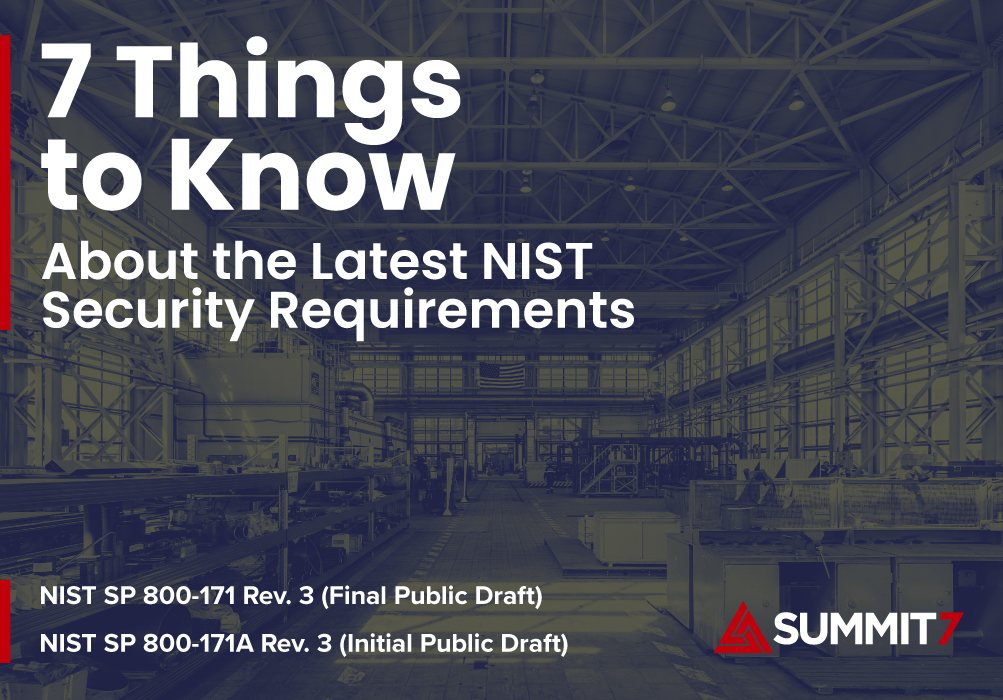Understanding NIST SP 800-171 Revision 3 with Dr. Ron Ross
Explore the improvements coming to NIST SP 800-171 Revision 3 with Dr. Ron Ross. Learn about key updates, new requirements, and the roll-out process.
After more than a year of development, revision 3 of NIST SP 800-171 and NIST SP 800-171A are officially done.
We were joined by Dr. Ron Ross to discuss what NIST learned from public comments, why NIST decided to add 19 new requirements, the thought process behind “ORC” controls, and what the future holds for the CUI series, rulemaking, and the NIST SP 800-53 catalog overall.
Watch the Podcast
Listen to the Podcast
This episode is from the Sum IT Up podcast. Click here to learn more.
Supplemental Resources for NIST SP 800-171 Revision 3
NIST released numerous supplemental resources along with NIST SP 800-171 revision 3 and NIST SP 800-171A revision 3.
“We found that supplemental materials are really important to our community because understanding what’s in the document – just reading the words – sometimes doesn’t go far enough, especially when you’re looking at new versions coming out. What are the changes? What are the deltas? What do all these things really mean?” – Dr. Ron Ross
- A summary press release.
- A digital version of the requirements within the Cybersecurity and Privacy Reference Tool (CPRT).
- Updates on the Protecting Controlled Unclassified Information project site.
- A Change Analysis spreadsheet explaining changes between SP 800-171 revision 2 and revision 3.
- A CUI Overlay spreadsheet with additional details for every line in SP 800-171 revision 3.
What has NIST learned during the revision process? Were you surprised by anything?
“We always learn in every one of these publication updates. I think what surprised me the most is the number of people that count every control and every subpart and every determination statement. I didn’t realize – frankly we never count the number of determination statements or the number of objectives in the publication. We basically try to define the requirement and then develop an assessment procedure. But that surprised me, how many people hang on every number.”
“One thing that surprised me was the [Organizationally Defined Parameter (ODP)] reaction and we kinda had to go down that road. Once you make the commitment to going into [NIST SP 800-53] you’re not going to be able to eliminate ODPs. But I was surprised. We had people that liked them and disliked them. They’re actually a pretty important part of finishing up and finalizing the requirements. My favorite one is the backup requirement. NIST is never gonna be in a position to tell an organization how often to backup because of [different settings/missions].”
Do you think NIST SP 800-171 revision 3 is a better standard compared to revision 2?
“Yes. It’s clearly a better guidance document. Why? First of all, we brought it up to code with [NIST SP 800-53 revision 5]. Second, it fills some critical gaps. One big gap that you all are very aware of (and the DIB especially) is the requirement for external service providers to make sure this information [is protected].”
Why 19 new requirements?
The number of requirements in NIST SP 800-171 revision 3 has decreased from 110 to 97 while the number of determination statements in NIST SP 800-171A revision has increased from 320 to 422.
Why did those 19 requirements make the cut?
“This process, as I said earlier, is not using formal methods and first order predicate calculus to come up with an answer. This is a process that is based on what I call a “tradespace decision”. When you build a system in the world of systems engineering there are all kinds of trade offs that are made. The same thing happens with us.”
The 19 New Requirements in NIST SP 800-171 Revision 3
03.04.10 System Component Inventory
03.04.11 Information Location
03.04.12 System and Component Configuration for High-Risk Areas
03.05.12 Authenticator Management
03.06.04 Incident Response Training
03.06.05 Incident Response Plan
03.10.07 Physical Access Control
03.10.08 Access Control for Transmission
03.11.04 Risk Response
03.12.05 Information Exchange
03.14.08 Information Management and Retention
03.15.01 Policy and Procedures
03.15.03 Rules of Behavior
03.16.01 Security Engineering Principles
03.16.02 Unsupported System Components
03.16.03 External System Services
03.17.01 Supply Chain Risk Management Plan
03.17.02 Acquisition Strategies, Tools, and Methods
03.17.03 Supply Chain Requirements and Processes
Dr. Ross’ closing thoughts
“It’s a lot of work but it’s worth the effort, that’s one thing that I would tell everybody. It’s hard to overstate this. With our total dependence on computing technology going into everything from IT systems to OT, IoT, etc., cyber-physical convergence has changed the landscape for everything that matters today. We know it’s a lot of work and we know it’s not going to be a smooth ride but with two steps forward and one step back you’re still making forward progress.”
Past episodes with Ron:
NIST Security Controls: Deep Dive with Dr. Ron Ross
NIST SP 800-171 revision 3 with Dr. Ron Ross
Sum IT Up Podcast
With Jacob Horne and Jason Sproesser
We sum up the news and developments relevant to CMMC, DFARS, and NIST standards such as SP 800-171, SP 800-53, the NIST Cybersecurity Framework, and others.





